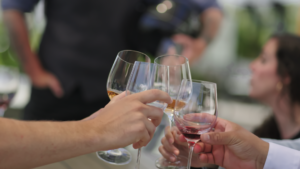Unraveling the Art of Wine Tasting: The 5 Essential Steps
Wine tasting is an art form that has been practiced for centuries. It’s a sensory experience that allows us to appreciate the complexity and beauty of wines from all over the world. Whether you’re a seasoned sommelier or a casual wine enthusiast, understanding the five steps of wine tasting can elevate your appreciation for this timeless beverage. This guide will walk you through these steps, helping you unlock the full potential of every sip.
Look: Observing the Wine’s Appearance
The first step in wine tasting is visual examination. Pour a small amount of wine into your glass, hold it up against a white background or in natural light, and observe its color and clarity. The appearance can give you clues about the wine’s age and quality.
White wines tend to darken as they age, shifting from pale yellow to a deeper gold or even brownish hue. Red wines, on the other hand, tend to fade with time, their vibrant ruby tones mellowing into brick red or garnet.
Clarity can also be telling; while some haziness might be expected in unfiltered wines, generally speaking, clearer wines are often considered higher quality than those with noticeable particles.
Swirl: Releasing Aromas
The second step involves swirling the wine gently in your glass. This action aerates the wine and helps release its various aromas. Be careful not to over-swirl as it could lead to spilling or excessive aeration that might alter the taste.
As you swirl your glass, observe how slowly or quickly the wine falls back down along the sides – this phenomenon is known as “legs” or “tears.” Wines with slower legs may have higher alcohol content or sweetness.
Smell: Identifying Aromas
After swirling comes one of the most crucial steps in wine tasting: smelling. The aroma of a wine can reveal a lot about its character and quality. Place your nose inside the glass and take a deep breath to inhale the bouquet.
Wines can exhibit a wide range of aromas, from fruits and flowers to herbs, spices, and more. Some wines may even have what’s known as “secondary” or “tertiary” aromas that come from the winemaking process or aging in oak barrels, respectively.
Taste: Savoring the Flavors
Now comes the moment you’ve been waiting for: tasting the wine. Take a small sip and let it coat your entire palate before swallowing or spitting it out (a common practice at formal tastings). Try to identify the different flavors present in the wine.
The taste should confirm what your nose detected in terms of fruit, floral, herbaceous, or spicy notes. Additionally, you’ll want to assess other elements like sweetness (or lack thereof), acidity (how tart it is), tannins (that dry sensation often associated with red wines), body (light-bodied vs. full-bodied), and alcohol content.
Evaluate: Reflecting on the Experience
The final step of wine tasting is evaluation. This involves reflecting on your overall experience with the wine. Did you enjoy it? Was it balanced or did certain elements overpower others? Would you drink it again?
Remember that there are no right or wrong answers here; wine tasting is highly subjective and personal.
Conclusion
As you embark on your wine tasting journey, remember that it’s not just about sipping and swirling; it’s about appreciating the artistry and craftsmanship that goes into each bottle. By mastering the five essential steps of wine tasting – look, swirl, smell, taste, evaluate – you can unlock a world of flavors and aromas that will enrich your wine experience.
If you’re looking to expand your wine horizons, consider exploring California wine country with Sidecar Tours. Their expert guides will take you on a journey through picturesque vineyards, where you can taste a variety of amazing wines and learn about the winemaking process. Whether you’re a wine novice or a seasoned enthusiast, a tour with Sidecar Tours is sure to be an unforgettable experience. Cheers to new adventures and discovering the art of wine tasting!

